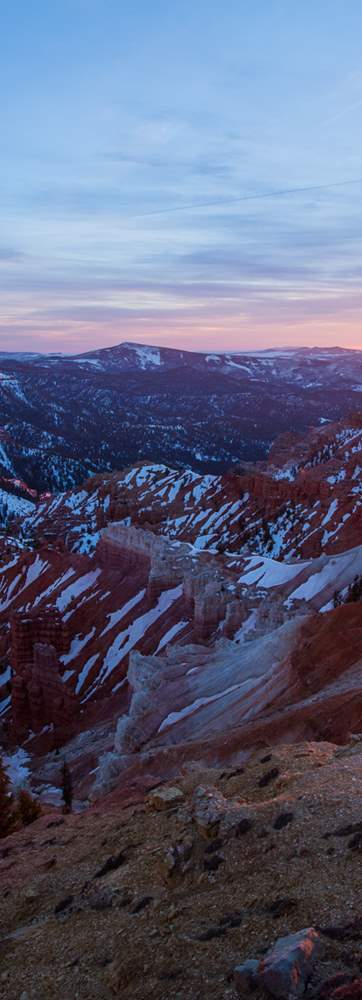
Cedar Breaks National Monument
-
Backcountry Hiking
For extreme hikers with wayfinding and backcountry experience, the Cedar Breaks area also offers a hike on par with Zion National Park's Subway. The Rattlesnake Creek Trail in the Ashdown Gorge Wilderness is a 2–3 day hike just outside the park boundary that crosses mostly designated wilderness in the Dixie National Forest and drops into the amphitheater below the canyon rim.
-
Dark Sky Park
The modern campground located on the edge of an alpine meadow is one of only a handful of dark sky parks in the world, making it one of the best locations for astral viewing. Far from any metro light pollution and high in altitude makes sleeping under the stars in the monument first class. Cedar Breaks holds stargazing programs with a ranger/naturalist throughout the summer months as part of its commitment to pristine night skies and the Dark Sky Parks certification.
-
Hiking
A hike to the Alpine Pond is a great way to stretch the legs. You can follow the lower loop into a forest of spruce trees. Here you are given a close look at the devastation inflicted by the spruce beetle epidemic. Beginning in the mid-1990’s a massive bark beetle outbreak made its way through the monument and surrounding Dixie National Forest, killing over half of the mature trees, adding even more unique color and texture to this fascinating environment. The Alpine Pond Trail takes you through a ghost forest of dead spruce offering views of the amphitheater framed by the skeleton trees. Arriving to the pond you will most likely see marmots sunbathing on its peaceful shore. Beyond the pond the trail will take you to the rim and beneath several bristlecone pine trees. Bristlecone pines are some of the oldest living organisms on earth and some in the monument have been dated to be more than 1,500 years old. The apex of the Alpine Pond Trail is the picturesque vistas of Chessmen Point. Return to the Alpine Pond Trailhead via the upper loop walking through meadows of wildflowers. Hiking to the Spectra and Rampart Points will take you along the Amphitheater’s rim. Beginning with the scent of wildflowers in your nose you will gradually make your way to the perfect overlook of Spectra Point (1 mile). From here you will get a closer look at the amazing geology of Cedar Breaks. Continuing on to Rampart Point (2 miles, one-way) you will follow an alpine stream through a beautiful forest of grand bristlecone pines. Their elegantly twisted bodies will show you the way.
What You’ll Remember
Iron oxides found in the rocks of the Amphitheater are the cause of the red, orange, and yellow colors. Magnesium oxides are responsible for the purple hues. Seeing this rainbow of muted colors within the badlands of Cedar Breaks creates a fantasyland you never could have imagined.
If you have time, a memory not to be missed is finishing the day at Point Supreme. Watching the shadow play across the Amphitheater as the sun sinks below the horizon is sure to put a smile on your face. Head back to camp and enjoy a delicious meal as the beauty of the Milky Way lights up the astral sky above.
The outrageous scenery of Cedar Breaks is candy for your eyes. Hiking the trails is perfect for those with a base level of fitness and suitable for a wide age group. If you like gorgeous alpine settings with great hiking, superb camping, and a lack of crowds Cedar Breaks National Monument is the place for you. The national monument is open from mid-May to mid-October, with camping available from mid-June to mid-September. There is a wildflower festival in July followed by some of the best autumn foliage in Utah.
During the winter season, Cedar Breaks is a premier cross-country skiing and snowmobiling destination with access from Brian Head Ski Resort. Also check the park calendar for parties in one of America’s top dark sky parks and when temperatures and snow conditions permit, a winter day use yurt/ranger station staffed on weekends by volunteers offering free hot chocolate to warm your snowy adventures.
Operating Hours and Fees
Cedar Breaks National Monument is open year-round, but the visitor center is generally closed for the winter season from mid-October to mid-May. During winter closure, visitor services are not available. Due to it's high elevation, snow can begin accumulating the park as early as late October and remain as late as early June.
Cedar Breaks requires an entrance fee: $15 for individuals on foot or bicycle, $25 per vehicle (valid for seven days); annual pass: $45.
Camping fees: $30/night at Point Supreme Campground (up to 8 people per site). The campground is generally open from mid-May to mid-September. For more information, visit nps.gov/cebr.
GPS Coordinates, Parking and Regulations
GPS coordinates of visitor center parking lot:
Directions:
Traveling south on I-15: Take exit 78 to Parowan. Travel south on Main Street for 1.3 miles. Turn left onto E. Center Street. Travel 0.3 Miles. Turn right onto Utah Highway 143 East. Continue approximately 15 miles to Cedar Breaks National Monument.
Traveling north on I-15: Take exit 57 to Cedar City. Travel north on Main Street for 2.2 miles. Turn right onto E Center Street/Utah Highway 14. Continue east on Utah Highway 14 for approximately 18 miles. Turn left onto Utah Highway 148 and continue 4 miles to Cedar Breaks National Monument.
The Patchwork Parkway Scenic Byway (S.R. 143)
Cedar Breaks is located along Utah State Route 143. Steeped in pioneer history and painted with some of Southern Utah's most stunning and unexpected scenic desert beauty, S.R. 143 (also known as the Patchwork Parkway) is a designated national scenic byway.






